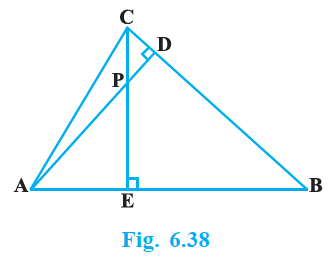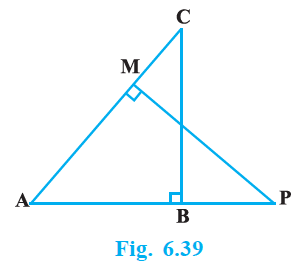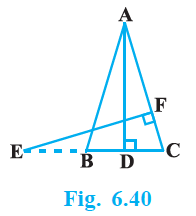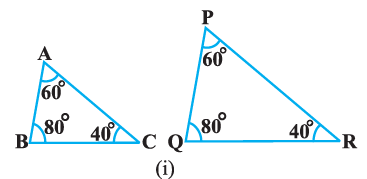 |
 |
 |
 |
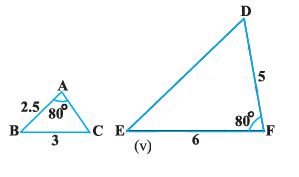 |
 |
| i) Given, in ΔABC and ΔPQR, $\angle A = \angle P = 60°$ $\angle B = \angle Q = 80°$ $\angle C = \angle R = 40°$ Therefore by AAA similarity criterion, ∴ ΔABC ~ ΔPQR |  |
|
(ii) Given, in ΔABC and ΔPQR, $\dfrac{AB}{QR} = \dfrac{2}{4} = \dfrac{1}{2}$ $\dfrac{BC}{RP} = \dfrac{2.5}{5} = \dfrac{1}{2}$ $\dfrac{CA}{PA} = \dfrac{3}{6} = \dfrac{1}{2}$ By SSS similarity criterion, ΔABC ~ ΔQRP |  |
|
(iii) Given, in ΔLMP and ΔDEF LM = 2.7, MP = 2, LP = 3, EF = 5, DE = 4, DF = 6 $\dfrac{MP}{DE} = \dfrac{2}{4} = \dfrac{1}{2}$ $\dfrac{PL}{DF} = \dfrac{3}{6} = \dfrac{1}{2}$ $\dfrac{LM}{EF} = \dfrac{2.7}{5} = \dfrac{27}{50}$ Since the ratios are not same $\dfrac{MP}{DE} = \dfrac{PL}{DF} ≠ \dfrac{LM}{EF}$ Therefore, ΔLMP and ΔDEF are not similar. |  |
|
(iv) In ΔMNL and ΔQPR, it is given, $\dfrac{MN}{QP} = \dfrac{ML}{QR} = \dfrac{1}{2}$ $\angle M = \angle Q = 70°$ Therefore, by SAS similarity criterion ∴ ΔMNL ~ ΔQPR |  |
|
(v) In ΔABC and ΔDEF, given that, AB = 2.5, BC = 3, $\angle A = 80°, EF = 6, DF = 5, \angle F = 80°$ Here , $\dfrac{AB}{DF} = \dfrac{2.5}{5} = \dfrac{1}{2}$ And, $\dfrac{BC}{EF} = \dfrac{3}{6} = \dfrac{1}{2}$ $\angle B ≠ \angle F$ Hence, ΔABC and ΔDEF are not similar. |  |
|
(vi) Given ΔDEF and PQR in ΔDEF ,by sum of angles of triangles, we know that, $\angle D + \angle E + \angle F = 180°$ 70° + 80° + $\angle F = 180°$ $\angle F = 180° – 70° – 80°$ $\angle F = 30°$ Similarly, In ΔPQR, $\angle P + \angle Q + \angle R = 180$ (Sum of angles of Δ) $\angle P + 80° + 30° = 180°$ $\angle P = 180° – 80° -30°$ $\angle P = 70°$ Now, comparing both the triangles, ΔDEF and ΔPQR, we have $\angle D = \angle P = 70°$ $\angle F = \angle Q = 80°$ $\angle F = \angle R = 30°$ Therefore, by AAA similarity criterion, Hence, ΔDEF ~ ΔPQR |  |




